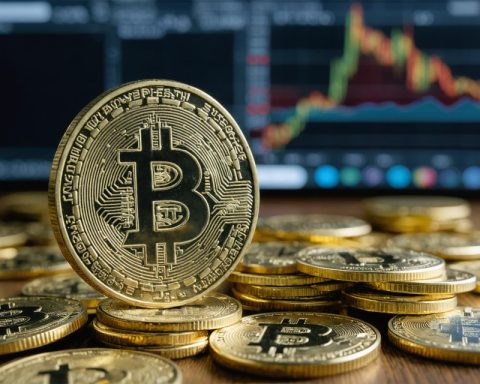- The SEC is reviewing Grayscale’s proposal for an XRP-focused exchange-traded fund (ETF).
- XRP is the fourth-largest cryptocurrency by market capitalization, and Grayscale’s initiative could enhance institutional adoption.
- The New York Stock Exchange Arca filed for a rule change, sparking hopes for the ETF’s approval.
- The SEC extended its review period, pushing the decision to May 21, 2025, to address the proposal’s complexities.
- An approved XRP ETF could revolutionize investment approaches and increase regulatory-driven confidence in the crypto market.
- The ongoing SEC deliberation highlights the balance between innovation and regulatory oversight in digital finance.
- This decision can significantly impact how traditional investors engage with digital assets.
The world of digital finance stands at a crossroads as the U.S. Securities and Exchange Commission (SEC) carefully navigates its decision on Grayscale’s audacious proposal to launch an exchange-traded fund (ETF) focused on XRP—a cryptocurrency known for both its fervent supporters and its fair share of controversy. Every tick of the clock is closely watched by investors whose hopes hinge on this potential breakthrough in institutional cryptocurrency adoption.
Grayscale, a titan in the crypto investment landscape, aims to capitalize on XRP, the world’s fourth-largest cryptocurrency by market capitalization. The New York Stock Exchange Arca took a significant step forward earlier this year by filing for a rule change with the SEC, thereby fostering hopes that this landmark fund could soon become a reality. As the clock wound down on April 6th, the SEC signaled its intention to take additional time, extending its review period beyond the initially anticipated timeline.
This opportunity could redefine investment approaches and open the cryptocurrency realm to a broader audience, potentially revolutionizing how traditional investors interact with digital assets. Yet, the SEC echoes caution, declaring its need for a more thorough review to address the complexities stemming from such an innovative proposal. The extension effectively pushes the final decision to May 21, 2025, allowing for broader consideration.
The stakes are as high as they are intriguing. An approved XRP ETF under Grayscale’s leadership might usher in a new era of regulatory-driven confidence and mainstream market participation. Yet, questions linger. Each deliberation by the SEC evokes intense scrutiny over the nuanced layers of regulation, highlighting the intricate dance between innovation and oversight.
This period of waiting underscores a vital truth in the rapidly evolving financial landscape: patience and due diligence remain key virtues. The SEC’s deliberation reflects a commitment not only to safeguarding the investing public but also to ensuring that the technological advancement in finance responsibly aligns with enduring regulatory principles.
As the financial world patiently waits, the anticipation serves as a poignant reminder of the delicate balance required to usher disruptive technologies into the financial mainstream. Rippling across digital and traditional investment realms alike, the pending decision on Grayscale’s XRP ETF stands as a pivotal moment—a testament to the ever-evolving dance between innovation and regulation.
Revolutionizing Cryptocurrency Investment: What the Grayscale XRP ETF Means for the Future
Understanding the Ripple Effect of Grayscale’s XRP ETF Proposal
The potential approval of Grayscale’s XRP exchange-traded fund (ETF) marks a significant moment in the intersection of cryptocurrency with traditional financial investment mechanisms. Here’s what you need to know about the proposal and its implications for the market.
XRP: A Brief Overview
XRP, the cryptocurrency developed by Ripple Labs, is well-known for its use in digital payment protocols and enterprise cross-border payment systems. Despite its controversy, primarily due to ongoing legal disputes with the SEC, XRP remains a dominant player in the crypto market, renowned for its swift transaction speeds and low costs.
Institutional Investors and Cryptocurrency: A New Paradigm
1. Increased Accessibility: If the Grayscale XRP ETF is approved, it could lower the barrier to entry for traditional investors, allowing them to gain exposure to XRP without the need to directly purchase or store the cryptocurrency.
2. Improved Credibility and Trust: An SEC-approved ETF would signal a level of regulatory endorsement, possibly fostering greater trust among hesitant institutional investors.
3. Market Volatility and Liquidity: The introduction of an XRP ETF could potentially reduce market volatility, as ETFs are often characterized by lower volatility compared to direct cryptocurrency holdings. It could also enhance market liquidity, influencing pricing stability.
How-to Steps for Investing in a Cryptocurrency ETF
1. Research ETFs: Understand the different types of cryptocurrency ETFs available, focusing on those with solid management and performance history.
2. Platform Selection: Choose a financial platform or brokerage that offers access to cryptocurrency ETFs.
3. Risk Assessment: Evaluate your risk tolerance and investment goals to decide how much of your portfolio should be allocated to cryptocurrency ETFs.
4. Portfolio Diversification: Use cryptocurrency ETFs as a diversification tool within a broader investment strategy.
5. Continuous Monitoring: Keep abreast of market trends and regulatory changes that could impact the ETF’s performance.
Market Forecasts & Industry Trends
Experts predict that the introduction of more cryptocurrency ETFs will catalyze mainstream cryptocurrency adoption. As regulatory frameworks become clearer, more institutional investors are expected to enter the space, potentially doubling the cryptocurrency market cap by the end of the decade.
Controversies and Limitations
– Regulatory Hurdles: The ongoing legal battles, like Ripple’s with the SEC, highlight regulatory uncertainties that could impact ETF approval and performance.
– Market Speculation: The hype surrounding new cryptocurrency ETFs can lead to speculative bubbles.
Security & Sustainability Concerns
– Security: Ensuring secure storage solutions for the digital assets underlying ETFs is paramount for protecting investors.
– Environmental Impact: Addressing the sustainability of cryptocurrency operations, particularly regarding energy consumption, remains crucial.
Actionable Recommendations
– Stay Informed: Regularly review the updates from the SEC and cryptocurrency market trends to understand potential investment impacts.
– Diversify Investments: Do not allocate excessive assets to cryptocurrency ETFs; maintain a balanced approach to risk management.
– Consult Financial Advisors: Engage with advisors who understand both traditional finance and cryptocurrency markets for tailored investment strategies.
For further insights and updates on digital finance, visit the official Grayscale website or the SEC for regulatory news. Use these resources to stay educated and make informed decisions in this exciting and evolving market landscape.















